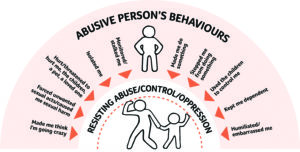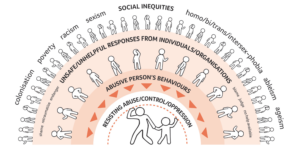Intimate partner violence is one form of family violence when someone is abused by an intimate partner or ex-partner.
The nature of intimate partner violence, as explained below, is often similar to the nature of family violence when it happens in other kinds of family relationships.
Intimate Partner Violence is a nearly always a pattern of coercive and controlling behaviours
Coercion is the use of force or threats to intimidate or hurt the person and make them afraid.
Someone trying to coerce or control a partner or ex-partner will use behaviours that most effectively keep that person trapped in the relationship, especially by targeting what is important to that person.
The pattern of behaviours used are often quite subtle to start with and become more obviously controlling over time. Controlling behaviours are used to isolate a person and make or keep them dependent on the abusive partner.
Coercive control is not just doing things to someone. It is also about stopping them from doing things for themselves, in other words limiting their freedom and choices and ability to make their own decisions about their own life. It is also about attacking that person’s dignity.
Coercive controlling behaviours have a cumulative impact, so that on any one occasion, the person is responding to their partner’s abuse at that moment as well as all the ways their partner has harmed them, and others, in the past.
The layers of entrapment
Entrapment by someone’s coercive controlling behaviours
Someone experiencing intimate partner violence (and often other forms of family violence) is trapped firstly by their (ex) partner’s coercive control.

Layers of entrapment - responses and social inequities
A person is entrapped not only by an abusive partner or family member’s coercive control and the cumulative impact of that behaviour over time, but also by the unhelpful responses of other people, organisations and society that ignore or minimise the abuse, blame the victim, or otherwise add to the impact of the abuse.
People who experience domestic violence often seek help, but the person abusing them will do what they can to stop them.
Experiencing social inequity (colonisation, sexism, poverty, racism, heteronormativity or homo/bi/trans/intersex-phobia, ableism, ageism) limits people’s safety options and increases the impact of the abusive person’s coercive controlling behaviours.
Read about the impact on children and parenting.